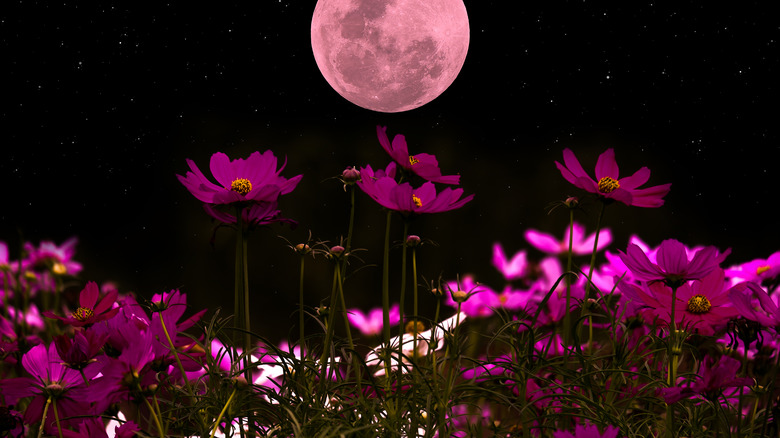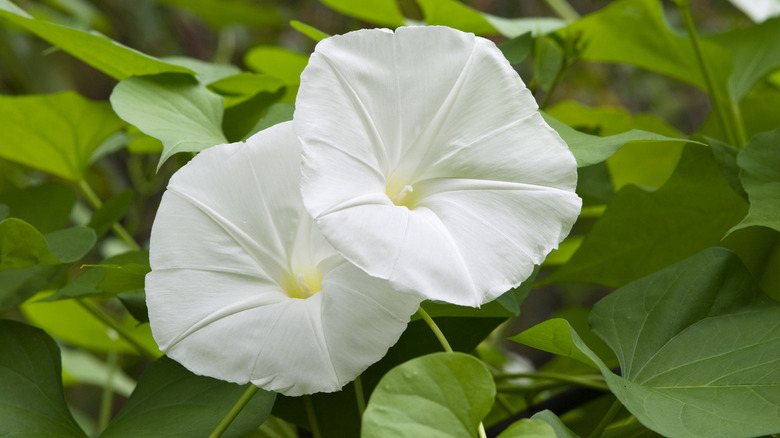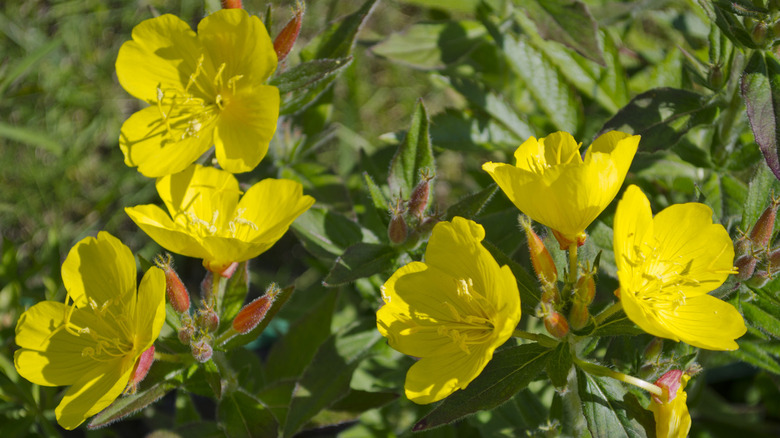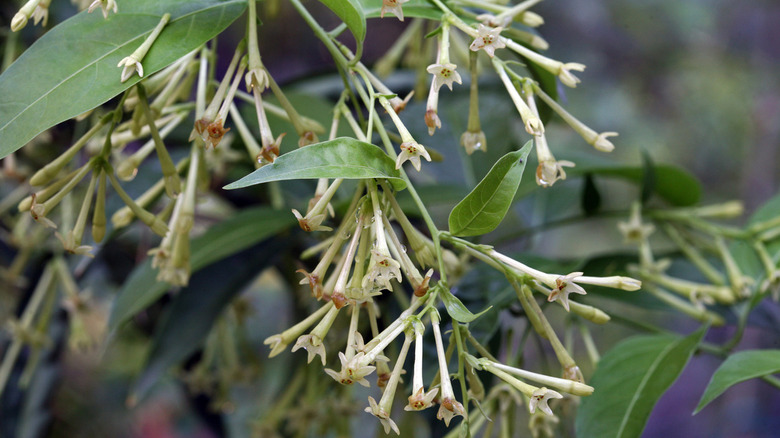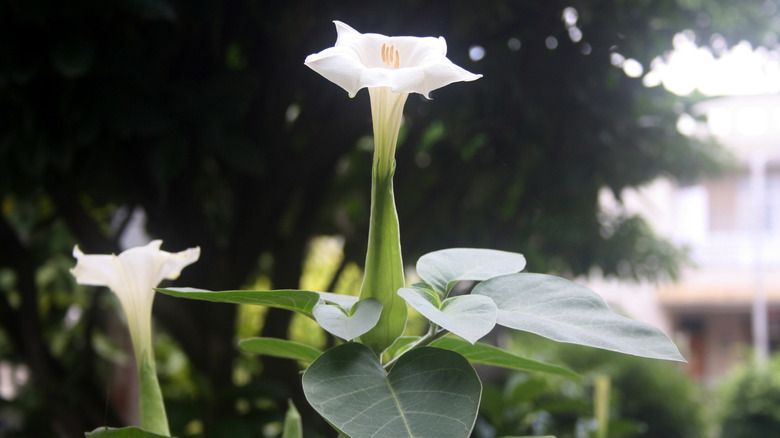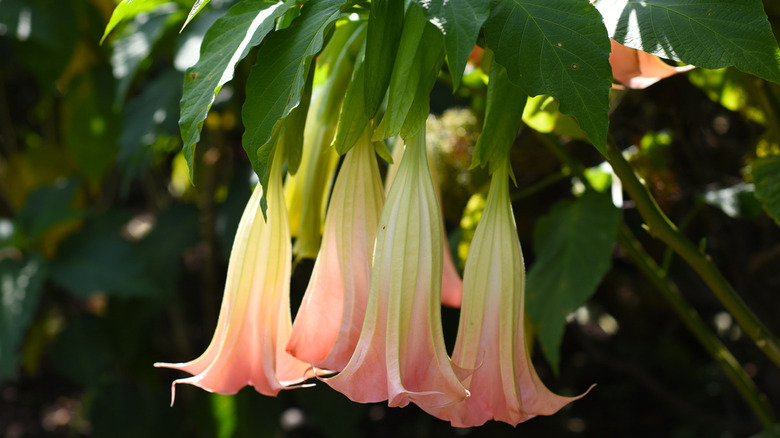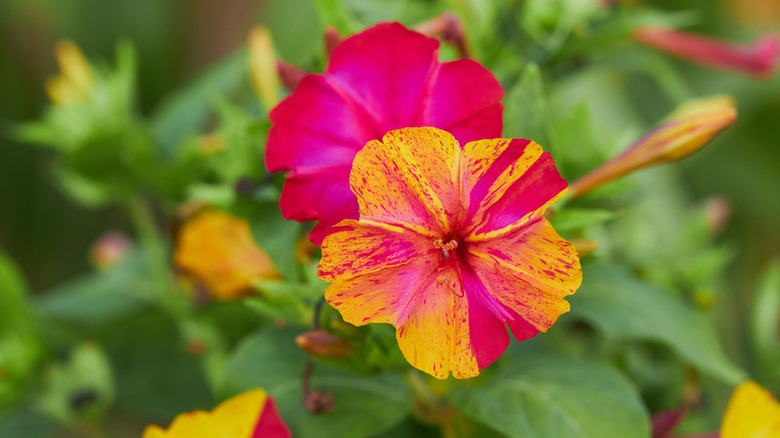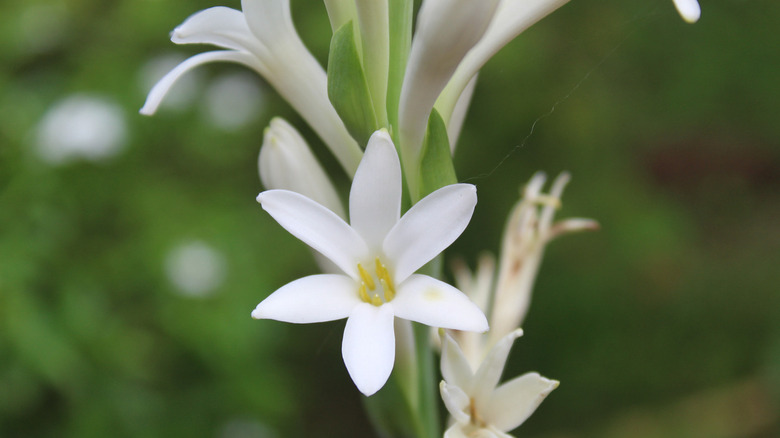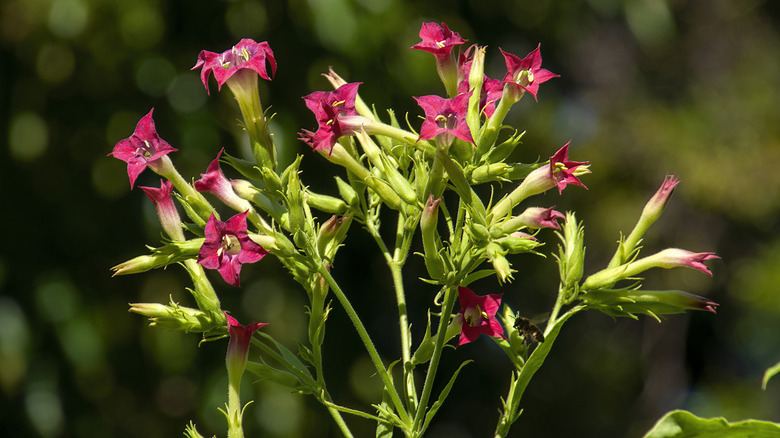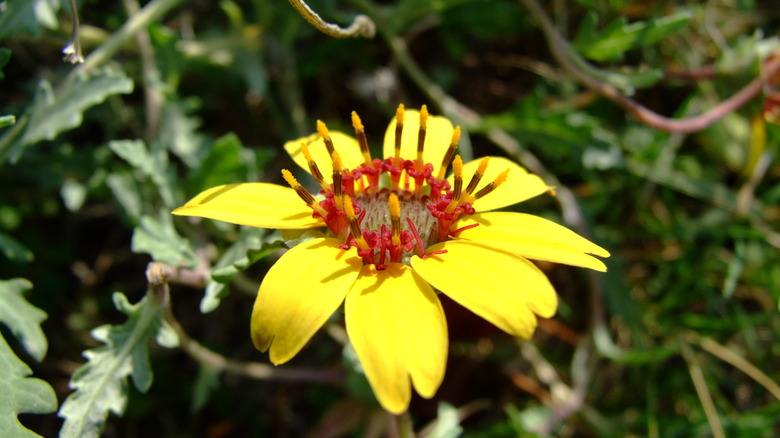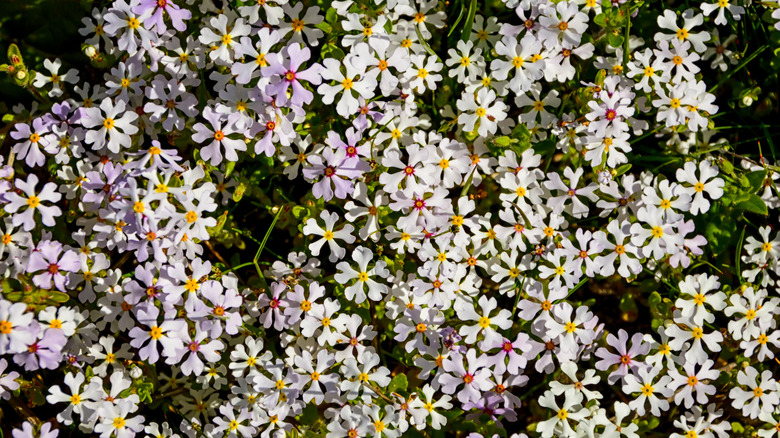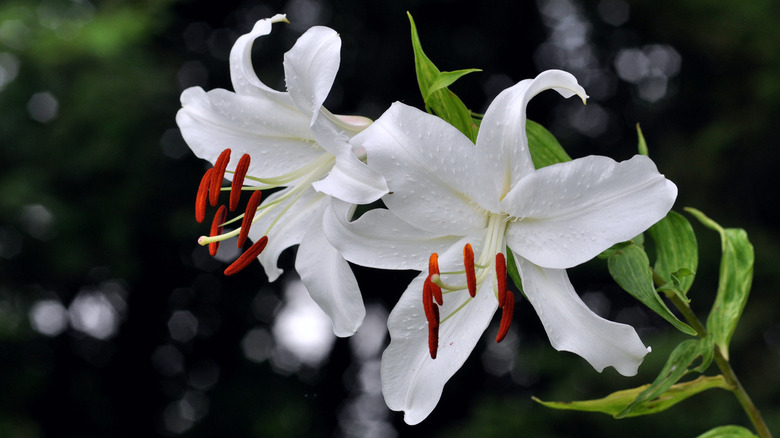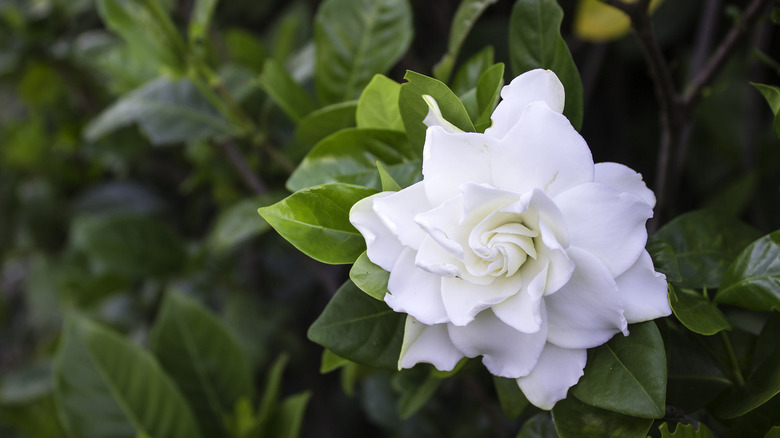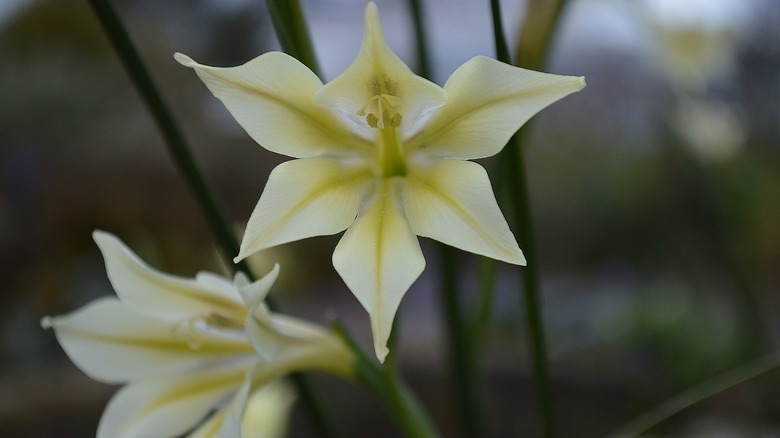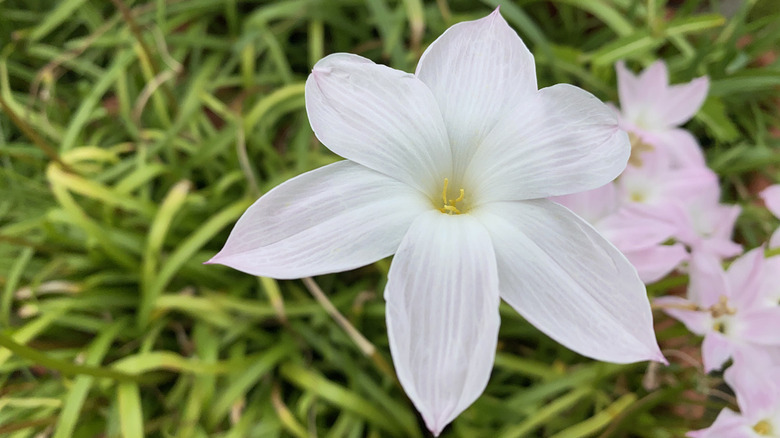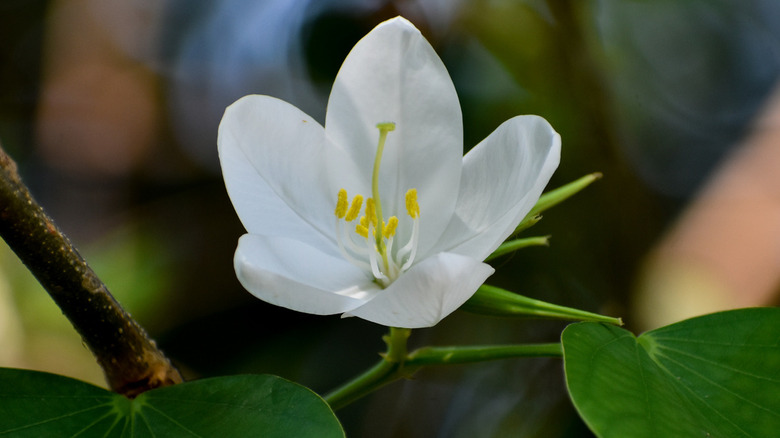15 Stunning Plants That Bloom At Night
Outdoor gardens look beautiful during the day; the rising sun often causes flowers to open up and show off in all their glory. However, have you ever stopped to think about how your flower garden looks during the night? A lot of flowers close up during the night when the sun is down and temperatures plummet, which can be disappointing because the garden loses its visual appeal. For the most part, this is not a problem; however, if you like enjoying your evenings on the patio or want to entertain visitors in the garden, it can be a bit frustrating.
Fortunately, there are plenty of night-blooming flowers that come alive during the night. Because they are nocturnal, night-blooming plants are often more aromatic to attract pollinators, via the Encyclopedia of Entomology. This is also why most night bloomers have white flowers reflecting the moon. Night bloomers give you the opportunity of enjoying the outdoors at night just as much as you would during the day. Take a look at these 15 stunning night blooming plant options to add to your moon garden.
1. Moonflower
The moonflower (ipomoea alba) is an incredibly beautiful vine with flowers that come alive during the night. It features large heart-shaped leaves and blooms into white flowers that are quite fragrant. Since it is a vine, this plant needs some support structure to crawl upon, mentions North Carolina State University Extension. The white flowers open up all night and only close in the morning.
Bloom Season: Summer to fall
USDA Growing Zone: 10 to 12
Growing Conditions: Full sun exposure
Soil Type: Well-drained moist soil
Size: 10 to 15 feet tall and 3 to 6 feet wide
2. Evening primrose
Bold and fragrant, the evening primrose (oenothera biennis) is a popular night bloomer that loves the shade and also tolerates medium bouts of drought (via Missouri Botanical Garden). Different from other night bloomers, the evening primrose produces yellow trumpet-shaped flowers. Because it is a biennial plant, it completes its cycle in two years, and flowers also develop in the second year.
Bloom Season: June to September
USDA Growing Zone: 4 to 9
Growing Conditions: Partial sun exposure
Soil Type: Well-drained loam soil
Size: 3 to 5 feet tall and 2 to 3 feet wide
3. Night-blooming jasmine
Although the flowers aren't as showy as other varieties, Night-Blooming Jasmine (cestrum nocturnum) is grown purposely for its sweet fragrance during the evening, details Monrovia. The highly fragrant white and yellow flowers attract pollinators like bees and butterflies to your garden. It has a long blooming season that goes all the way through summer.
Bloom Season: Summer
USDA Growing Zone: 8 to 11
Growing Conditions: Partial sun exposure
Soil Type: Moist, well-drained soil
Size: 8 to 10 feet tall and up to 3 feet wide
4. Devil's trumpet
Grown majorly as annuals or short-lived perennials, the devil's trumpet (datura meteloides) is another night blooming shrub that will light up your garden in the evening. It blooms in large trumpet-shaped flowers that may appear in several colors, including purple, white, lilac, and yellow. One distinct characteristic of this plant is that the blooms linger until noon the following day ( via University of Wisconsin-Madison Division of Extension).
Bloom Season: Summer
USDA Growing Zone: 9 to 10
Growing Conditions: Full sun exposure
Soil Type: Moist, well-drained soil
Size: 3 to 4 feet tall and 3 to 4 feet wide
5. Angel's trumpets
The angel's trumpet (brugmansia) is a soft perennial shrub that can also be grown as a small tree. It's quite similar to the devil's trumpet, and the only way to tell them apart is by looking at the direction of the flowers. The angel's trumpet plant has downward-facing flowers. Remember, this plant must reach maturity before blooming, which takes a year or longer (via North Carolina State University Extension).
Bloom Season: Summer, fall
USDA Growing Zone: 9 to 10
Growing Conditions: Full sun exposure
Soil Type: Loamy well-drained soil
Size: 2 to 3 feet tall and 3 to 6 feet wide
6. Four o'Clock
True to their name, the four o'Clock (mirabilis jalapa) blooms during this time of the day and only wilts in the morning. This plant is quite tough and is capable of tolerating drought. It produces fragrant flowers that may appear in shades of white, yellow, pink, or magenta. Remember, this shrub loves the sun and grows quite fast in ideal conditions (via University of Florida Gardening Solutions).
Bloom Season: Summer, fall
USDA Growing Zone: 9 to 11
Growing Conditions: Full sun exposure
Soil Type: Moist, well-drained soil
Size: 2 to 3 feet tall and wide
7. Tuberose
The tuberose (polianthes tuberosa) is a popular plant that is grown purposely for its strong fragrance. It blooms in beautiful waxy, elongated flowers that tend to shrivel up under extreme heat. This is why they prefer blooming at night when the temperatures are low. It can be commercially grown for flowers, especially in greenhouses where flowering can be induced all year round, mentions Plants For A Future.
Bloom Season: August to September
USDA Growing Zone: 8 to 11
Growing Conditions: Full sun exposure
Soil Type: Neutral well-drained loamy soil
Size: 2 to 3 feet tall and wide
8. Flowering tobacco
Although not a typical garden plant, the flowering tobacco (nicotiana) blooms in colorful flowers, perfect for your night garden. There are several species under the nicotiana banner that are used as ornamental plants, and nicotiana sylvestris is the most popular (via the University of Wisconsin-Madison Division of Extension). If you want to introduce some color into your garden, consider the vibrant red or pink nicotiana.
Bloom Season: Summer, fall
USDA Growing Zone: 10 to 11
Growing Conditions: Partial sun exposure
Soil Type: Moist, well-drained soil
Size: 3 – 5 feet tall and 1 to 2 feet wide
9. Chocolate Daisy
The chocolate daisy (berlandiera lyrata) is a versatile plant that can be used as an herb and also for its ornamental properties. The name 'chocolate daisy' has nothing to do with the color, in fact, it is derived from the sweet cocoa aroma that comes from the flowers early in the morning (via Santa Fe Botanical Garden). Under the sun, this plant hangs the flowerhead down and only comes back up during the cool night temperatures.
Bloom Season: Summer
USDA Growing Zone: 4 to 10
Growing Conditions: Partial sun exposure
Soil Type: Moist well-drained soil
Size:1 to 2 feet tall and 1 to 2 feet wide
10. Night phlox
Zaluzianskya capensis, better known as the night phlox, is a low-growing plant native to South Africa. It is a good addition to your moon garden thanks to the beautiful flowers that open up during the night producing a pleasant scent (via the South African National Biodiversity Institute). The purple bulbs grow up to a foot in height making it an ideal plant for garden borders.
Bloom Season: Summer to fall
USDA Growing Zone: 9 to 11
Growing Conditions: Partial sun exposure
Soil Type: Well-drained soil
Size: Up to 1 foot tall and wide
11. Casablanca lily
The casablanca lily (lilium "casa blanca") is purposely bred for its ornamental value. It is an oriental hybrid cultivar that is popular for its white flowers and strong sweet scent. To create more visual interest in your garden, it is advisable to plant this flower in groups. Keep an eye on diseases like lily mosaic though. Nonetheless, according to the Missouri Botanical Garden, the casablanca lily is fairly low maintenance and easy to grow.
Bloom Season: Summer
USDA Growing Zone: 4 to 9
Growing Conditions: Full sun
Soil Type: Moist, well-drained soil
Size: 3 to 4 feet tall and 1 foot wide
12. Gardenia
Another worthy addition to your moon garden is the gardenia (gardenia jasminoides). The white flowers come to life during warm summer evenings, releasing a sweet scent that attracts pollinators. During the bloom season, the emerald white flowers contrast nicely against the deep green foliage the flower emerges from. You can plant them in containers so that you bring them indoors during winter (via North Carolina State University Extension).
Bloom Season: Summer
USDA Growing Zone: 8 to 11
Growing Conditions: Part shade
Soil Type: Rich, acidic soil
Size: 5 to 6 feet tall and wide
13. Night gladiolus
Night gladiolus (gladiolus tristus) is a pale yellow flower that blooms in the evening. The name gladiolus was coined from the Greek word "gladius," which means sword thanks to the long pointed stalk. This plant produces several flower colors, including lavender, purple, white, yellow, and pink (via Purdue University).
Bloom Season: Summer
USDA Growing Zone: 7 to 8
Growing Condition: full sun
Soil Type: Neutral well-drained soil
Size: 2 to 4 feet tall and 1 to 2 feet wide
14. Evening rain lilies
If you are interested in a flower with a sweet scent in your moon garden, then the evening rain lilies (zephyranthes drummondii) is a good choice. The white dainty flowers that show off in the evening might appear high maintenance, but on the contrary, they are quite easy to maintain. They love the shade but still do well under controlled exposure to the sun, mentions the North Carolina State University Extension.
Bloom Season: Spring to Summer
USDA Growing Zone: 7 to 10
Growing Condition: Partial exposure
Soil Type: Moist, well-drained soil
Size: 6 inches to 1 foot tall and 12 to 18 inches wide
15. Mock orange
The mock orange (philadelphus coronaius) is a deciduous shrub loved for its white flowers and sweet fragrance. The flowers take a cup shape resembling a small orange hence the name. During spring, the flowers look elegant, especially against dark green foliage. The mock orange is a fast-growing shrub perfect for your moon garden edge (via Arbor Day Foundation).
Bloom Season: Spring
USDA Growing Zone: 4 to 8
Growing Condition: Full sun to partial exposure
Soil Type: grows in every type of soil
Size: 10 to 12 feet tall and wide

